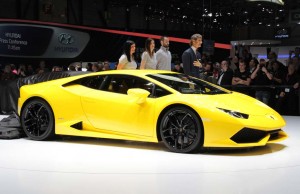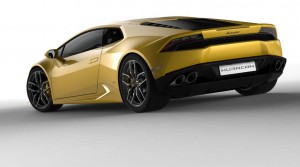It was a Category 4 opening for the 2014 Geneva Motor Show with Lamborghini staging the opening news conference and rolling out its all-new Huracan LP610-4.
The Huracan maintains the basic styling cues of the older sports car, a look that’s as much fighter jet as automobile. But there are subtle new details, some borrowed from the maker’s top-line model, the Aventador, most obviously the wedge-shaped silhouette. The Huracan adds side panels gently sculpted to channel air through scoops behind the passenger compartment for the rear-mounted engine.
“It is revolutionary yet immediately recognizable,” suggested Lamborghini CEO Stefan Winkelman, as the covers were lifted off the new two-seater.
The name of the new model has dual significance. As a video the maker prepared for the debut suggested, the new Lamborghini Huracan can outrun a hurricane. But, noted Winkelman, “in the best Lamborghini tradition, Huracan is (actually) the name of a fighting bull.” The four-legged Huracan did something few bulls have done in the ring, retiring in 1879 undefeated by even the best matadors of the day.
As for the rest of the name, it reveals the rest of the story, the new model punching out a hefty 610 horsepower from its direct-injected 5.2-liter 10-cylinder engine through a 7-speed dual clutch gearbox – Lamborghini’s first – that puts power to the pavement through all four wheels.
What you may also need to know is that Lamborghini promises the new Huracan will launch from zero to 100 kmh (zero to 60 mph) in just 3.2 seconds, while hitting 200 kmh – or 125 mph – in 9.9 seconds. Top speed is rated at 201 mph.
There’s a button on the steering wheel that, in English, translates as “soul,” and it, fittingly, transforms the car’s behavior from almost tame to track-level performance.
In keeping with the auto industry’s new reality, Lamborghini put more emphasis than ever before on fuel economy, though that effort also helped improve performance and handling. The Huracan is based, for one thing, on a new hybrid aluminum/carbon fiber architecture that is both lighter and stiffer than the old Gallardo platform, noted Winkelman.
(Maserati hints at future with Alfieri 2+2 Concept. For more, Click Here.)
Add a new stop/start feature – which can automatically shut the engine off instead of idling, then restart it when the driver’s foot lifts off the brake – and the new Lamborghini Huracan is expected to yield 18.5 mpg – miraculous numbers in this sort of supercar.
(Click Here for details about how Jeep is making small feel big.)
The outgoing Gallardo was the best-selling car in Lamborghini history and helped the maker’s global volume surge to 2,083 in 2012. Though the new Lamborghini Huracan won’t reach market till late this year it apparently is already showing itself a worthy successor. According to Winkelmann, the Italian maker has so far rolled up more than 1,000 advance orders.
Lambo can use the momentum, as it gets set for an onslaught of new competitors in the small but lucrative supercar market. British rival Aston Martin, for one, expects to soon bolster its own line-up thanks to an agreement it recently inked with Daimler AG to get V-8 engines from the German maker’s AMG arm.
(To see Jaguar’s plans for the new XE compact sedan, Click Here.)
For the moment, no word on pricing for the new Lamborghini Huracan but the outgoing Gallardo started at $181,900 in the U.S. The likelihood is at least a modest jump when the new model comes to market.



